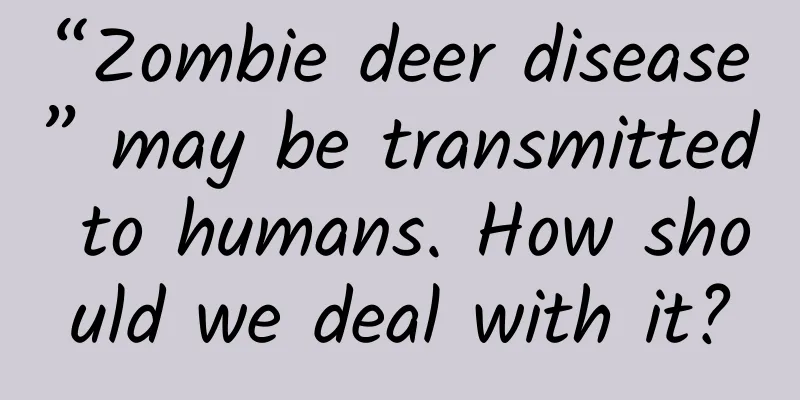“Zombie deer disease” may be transmitted to humans. How should we deal with it?

|
"Zombie deer disease" has appeared in the United States! This news reminds many people of the deer at the beginning of the movie "Train to Busan": stumbling and distracted... This is not the first time that "zombie deer disease" has appeared globally Overseas Network quoted a report from Fox News on December 23 that the first case of "zombie deer" disease was discovered in Yellowstone National Park in the United States, causing concern among some scientists that this fatal brain disease virus could be transmitted to humans. It was reported that in November 2023, a deer carcass in Yellowstone National Park in the United States tested positive for a highly contagious prion, which can cause the deer to lose weight, fall, and develop neurological symptoms. Zombie deer disease was first discovered in mule deer by a government research institute in northern Colorado in 1967. Since then, the disease has spread to at least 30 states in the United States and has been documented in Norway, Sweden, Finland, Canada, South Korea and other countries. What exactly is "zombie deer disease"? "Zombie Deer Disease" vividly depicts the symptoms of sick deer. It is a chronic wasting disease caused by prions. It is a transmissible spongiform encephalopathy (TSE) that affects deer, similar to diseases such as "mad cow disease". Prions are transmitted through body fluids and physical contact, attacking the brain, spinal cord and other tissues of deer. Most cases of "zombie deer disease" occur in adult animals: The first sign is difficulty moving. Weight loss. The most obvious and consistent clinical symptom of this disease is weight loss over time. Behavioral changes also occur in most cases. These include decreased interaction with other animals, listlessness, lowering the head, trembling, and walking in a repetitive pattern. Excessive salivation and teeth grinding. Increased water intake and urination. ·Not afraid of people and aggressive. Can “zombie deer disease” be transmitted to humans? Some animal studies have shown that "zombie deer disease" poses a risk to certain types of non-human primates (such as monkeys) because these animals eat meat from animals infected with prions and may also come into contact with the brains and body fluids of infected deer. Such studies have raised concerns about the risk of the virus "spreading to humans." The disease is deadly to animals and there is no treatment or vaccine. No human cases of infection with the "zombie deer" virus have been found. Some epidemiologists believe that the lack of "transmission" to humans does not mean that it will not happen. The U.S. Public Wildlife Alliance estimated in 2017 that approximately 7,000 to 15,000 animals infected with "zombie deer disease" are eaten each year, and this number is increasing at a rate of 20% per year. With the arrival of hunting season, the U.S. Centers for Disease Control and Prevention calls on people to test hunted animals before eating meat. The World Health Organization recommends that the best way to prevent the pathogens of all known prion diseases from entering the human food chain is to stay away from these animals, especially not to eat animals that may be sick. People should not eat wild animals, purchase meat from regular channels, and cook meat thoroughly when cooking. References: 1. "Zombie deer" virus detected in Yellowstone Park, USA, experts warn: it may infect humans 2. Chronic wasting disease |
<<: Is it reliable to take Western medicine while drinking Chinese medicine?
>>: Bread crumbs scattered on Mars: Hansel and Gretel, please reply!
Recommend
Facebook advertising process!
More and more foreign trade companies are beginni...
A sales copywriting framework that converts orders and relies on it!
Compared with the requirements for other types of...
Do you know the dangers of not cleaning your refrigerator? Bacteria will set up camp and the odor will not go away!
For many families, the refrigerator is the "...
How to use Xiaohongshu’s algorithm mechanism for oral medical beauty marketing and promotion?
If medical beauty marketing is limited to product...
【Game Promotion】See how the major game manufacturers do it! Marketing promotion strategy
Let’s take a look back at the last month of 2014....
Hibernating underground for dozens of months, it amazed me the whole summer when it opened
Nothing heralds the arrival of summer better than...
After the stock price soared, is Thunder Wanke Coin really a scam?
Recently, something extraordinary seems to have h...
How much does it cost to develop a food mini app in Yangjiang?
The main factors affecting the price of mini prog...
Apart from the old joke of "see you tomorrow", you don't understand Enoki mushrooms!
When hearing the word "Enoki mushroom",...
It's this again! Another fire caused by charging an electric car indoors! How to eliminate safety hazards?
Recently, Qingpu District, Shanghai Before an emp...
7 important details of Toutiao’s information flow delivery can increase your conversion rate by 50%!
As WeChat and Weibo operations become increasingl...
Dr. Mo explains the Apple-Google smartphone war: Both giants face challenges
[[124508]] The American technology blog Re/code w...
Android 11, a detailed account of the vivid history from version 1.0 to 10.0
[[277134]] From its first release in 2008 to toda...
How to make your Tik Tok VLOG become popular content?
Tik Tok is a short video software used by many yo...
China's "King of Deserts" is covered in snow, and netizens are furious to find out the truth...
Recently, the Taklimakan Desert in Xinjiang welco...









